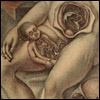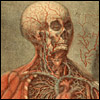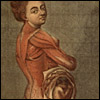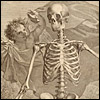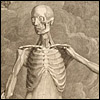
Monumental Books and Anatomical Pleasures
In the 17th and 18th centuries, the development of mezzotint, and printing methods that combined etching and engraving, made it possible to make anatomical illustrations of startling beauty and painterly texture. Published in monumental scale and on fine paper, these plates were spectacles of anatomical science, artistry and advanced print technology—the final act of anatomy’s theatrical tradition. Their intended audience was an elite group of wealthy men of learning and discernment. Two notable exponents of this extravagant anatomy were the German anatomist Bernhard Siegfried Albinus (1697-1770) and French artist-printer-publisher Jacques Fabien Gautier d’Agoty (1711-1785).
Monumental
Books
Next
Topic: Beautiful
Ugliness: Bidloo
Another
Reality
Next Section: Visionary and Visible
U.S. National Library of Medicine, 8600 Rockville Pike, Bethesda, MD 20894
National Institutes of Health, Department of Health & Human Services
Copyright, Privacy, Accessibility
Last updated: 13 February 2003
|
Gautier d’Agoty’s amazing technicolor dream dissections In the mid-1700s, Gautier d’Agoty perfected a method of printing colored layers of mezzotint (a technique that allows for subtle gradations of shading). The resultant anatomical illustrations look like paintings on a page, and are remarkable for their brilliance, gaiety, eccentricity, delicacy and (paradoxically) crudity. As a subject, anatomy was particularly well suited to display Gautier d’Agoty’s mastery of advanced print technology. It also gave him license to show parts of the body not permitted in other genres of illustration. The aim was to dazzle more than instruct. Anatomical ideal: the monumental atlas of Bernhard Siegfried Albinus B.S. Albinus, professor of anatomy at Leiden, proposed in the 1720s to make the most detailed, beautiful, and comprehensive anatomical atlas ever published, using stylized figures representing an ideal humanity. He never completed the project, but did finish a part, Tabulae Sceleti e Musculorum Corporis Humani (1747)—the last great medical anatomy to use imaginative elements. According to Albinus, the poetically evocative backdrops were designed to "agreeably" fill "the empty spaces" and make the figure look three-dimensional. Later editions omit the backgrounds, a concession to the movement to rid anatomy of extraneous illustration and ornament. |
